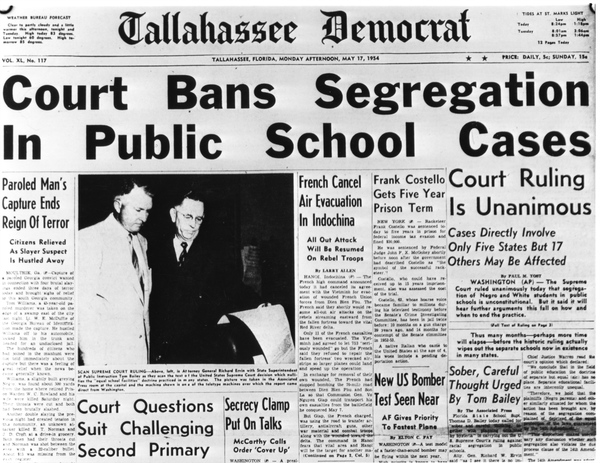Although Brown v. Board of Education[1]ended the “separate but equal” Supreme Court ruling of Plessy v. Ferguson,[2] Florida acted quickly to circumvent its intention. At the time of the ruling announcement, one of the two gubernatorial candidates, the incumbent Charley Johns, stated he would call a special session of the Legislature to address the issue. The challenger, LeRoy Collins, stated his support for segregation and his intention keep segregated schools if elected, which he was. [3]
One year later, the Supreme Court decided that the issues in Brown v. Board of Education were the responsibility of local school districts to solve and that they should move with “all deliberate speed” to end segregation.[4] The same day, the Florida legislature petitioned Congress to pass legislation or add a constitutional amendment that would allow local school boards to govern their school districts as they deemed appropriate.[5] This had the net result of slowing racial integration, as school districts could determine the pace of their “deliberate speed.”
Furthermore, in 1956, then-Governor Collins signed the School Assignment Law, which directed that local school boards assign students to schools based on such factors as intelligence, aptitude, etc. This new law – which reflected the recommendations of a report authored by the Fabisinski Committee, a group convened to design a legal approach to circumventing racial integration – allowed schools to deny Black parents’ requests to send their children to all-white schools[6] on “grounds other than race.” In effect, this slowed racial integration, as it was intended to do. It was not until after the passage of the federal Civil Rights Act in 1964 and federal oversight that Florida made significant progress towards desegregation.
References:
[1] Brown v. Board of Education of Topeka, United States Supreme Court, 347 U.S. 483 (1954).
[2] Plessy v. Ferguson, United States Supreme Court, 163 U.S. 537 (1896).
[3] Deidre Cobb-Roberts and Barbara Shircliffe, “The Legacy of Desegregation in Florida”, in Kathryn M. Borman and Sherman Dorn, Eds. ‘Education Reform in Florida: Diversity and Equity in Public Policy. Albany, New York: State University of New York Press, 2007.
[4] Brown II, 349 U.S. 294 (1955).
[5] Deidre Cobb-Roberts and Barbara Shircliffe, “The Legacy of Desegregation in Florida”, in Kathryn M. Borman and Sherman Dorn, Eds. ‘Education Reform in Florida: Diversity and Equity in Public Policy. Albany, New York: State University of New York Press, 2007.
[6] Deidre Cobb-Roberts and Barbara Shircliffe, “The Legacy of Desegregation in Florida”, in Kathryn M. Borman and Sherman Dorn, Eds. ‘Education Reform in Florida: Diversity and Equity in Public Policy. Albany, New York: State University of New York Press, 2007.
